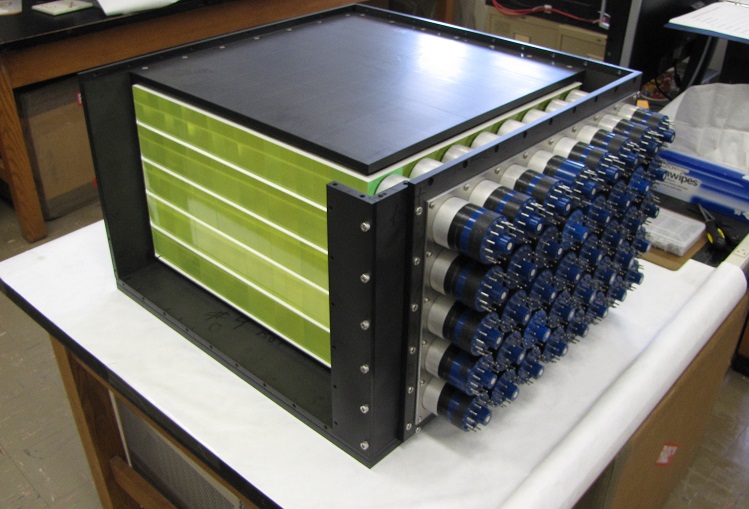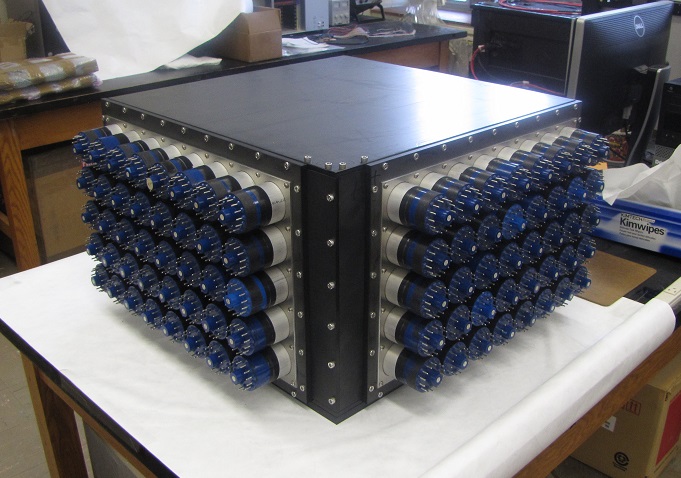Features Archive
CHANDLER Assembly Completed for Next Stage in the Program
Over the course of the last two weeks, the CHANLER reactor neutrino detector team has assembled their MiniCHANDLER prototype detector. This inaugurates the final stage of a two-year R&D program that began with the MicroCHANDLER prototype and will wrap up with a deployment and test run of MiniCHANDLER at the North Anna Nuclear Power Plant. MiniCHANDLER is comprised of 320 cubes of wavelength shifting plastic scintillator cubes and 6 thin sheets of lithium-6 (6Li) loaded zinc sulfide (ZnS) scintillator. The 6-cm cubes are arraigned in five layers of 8×8 cubes which are separated by the 6Li-loaded ZnS sheets. The cubes and sheets are well suited for detecting electron antineutrinos from nuclear reactors, which produce a positron and a neutron when they interact in the plastic cubes. The positron produces a prompt flash of light in the cube, while the neutron bounces around for a while before capturing on the 6Li in the sheet producing a delayed flash of light. The correlation between these two distinct events provides a clean indication of a neutrino interaction. The light from both the sheets and cubes is transported by total-internal-reflection along the rows and columns of cubes to the surface of the detector where it is read out by light detectors known as photomultiplier tubes (PMTs). MiniCHANDLER uses 80 PMTs. This unique method for reading out the light, known as a Raghavan optical lattice, was invented by the late CNP member Raju Raghavan. It provides precise spatial information for the neutrino interaction and neutron capture, which will be used to separate the true neutrino events, which must be close together in both time and space, from the random correlation of unassociated neutron captures and positron-like events that would otherwise form fake neutrino events.
Upon the successful completion of testing at the power plant the team will prepare to build the full-scale
detector consisting of a ton of cubes read out by over 1000 PMTs. This detector could be used to search for
neutrino oscillations mediated by a proposed fourth neutrino type, known as a sterile neutrino, and may be
useful for monitoring the core of nuclear reactors, perhaps even as a part of a verification program for
nuclear non-proliferation.

|
| The MiniCHANDLER Detector shown with half of its PMTs installed (on the right). The cubes (green) and sheets (white) are visible on the left. |

|
| The completed MiniCHANDLER Detector with all of its PMTs and sealed up against outside light. |
Archived Feature Articles
- Shunsaku Horiuchi Solves Dark Matter Mystery (08/27/20)
- Rebekah Pestes Wins the 2020 Scharff-Goldhaber Prize (07/02/20)
- Neutrino Anomalies in Antarctica Explained by Prof. Ian Shoemaker (09/09/20)
- Professor Huber Details How Antineutrino Detectors Could Aid Nuclear Nonproliferation (03/12/20)
- CNP Researchers Publish Neutrino Observation with the Mobile Neutrino Detector (03/11/20)
- CUORE Sets New Limits on Neutrinoless Double Beta Decay (03/11/20)
- CNP scientists Win Cosmology Prize for Research About Dark Matter and Dark Energy (04/29/19)